Nursing Research: Clinical Communication and Patient Safety Report
VerifiedAdded on 2020/03/04
|12
|2151
|151
Report
AI Summary
This nursing research report delves into the critical role of clinical communication in healthcare, emphasizing its impact on patient health and safety. The report highlights the importance of effective communication skills, including verbal, non-verbal, and written communication, in fostering positive patient-nurse relationships and ensuring patients understand their medical conditions and treatment plans. It explores various methods for delivering optimal communication, such as standardized tools, situational awareness, and the use of critical language, to enhance patient safety and minimize miscommunication. The report also discusses the significance of communication with physicians and the implementation of strategic plans within healthcare organizations to improve communication quality. A summary table is included, providing an overview of several studies related to clinical communication, their aims, methodologies, and key findings, reinforcing the need for continuous improvement in communication practices to enhance patient outcomes.
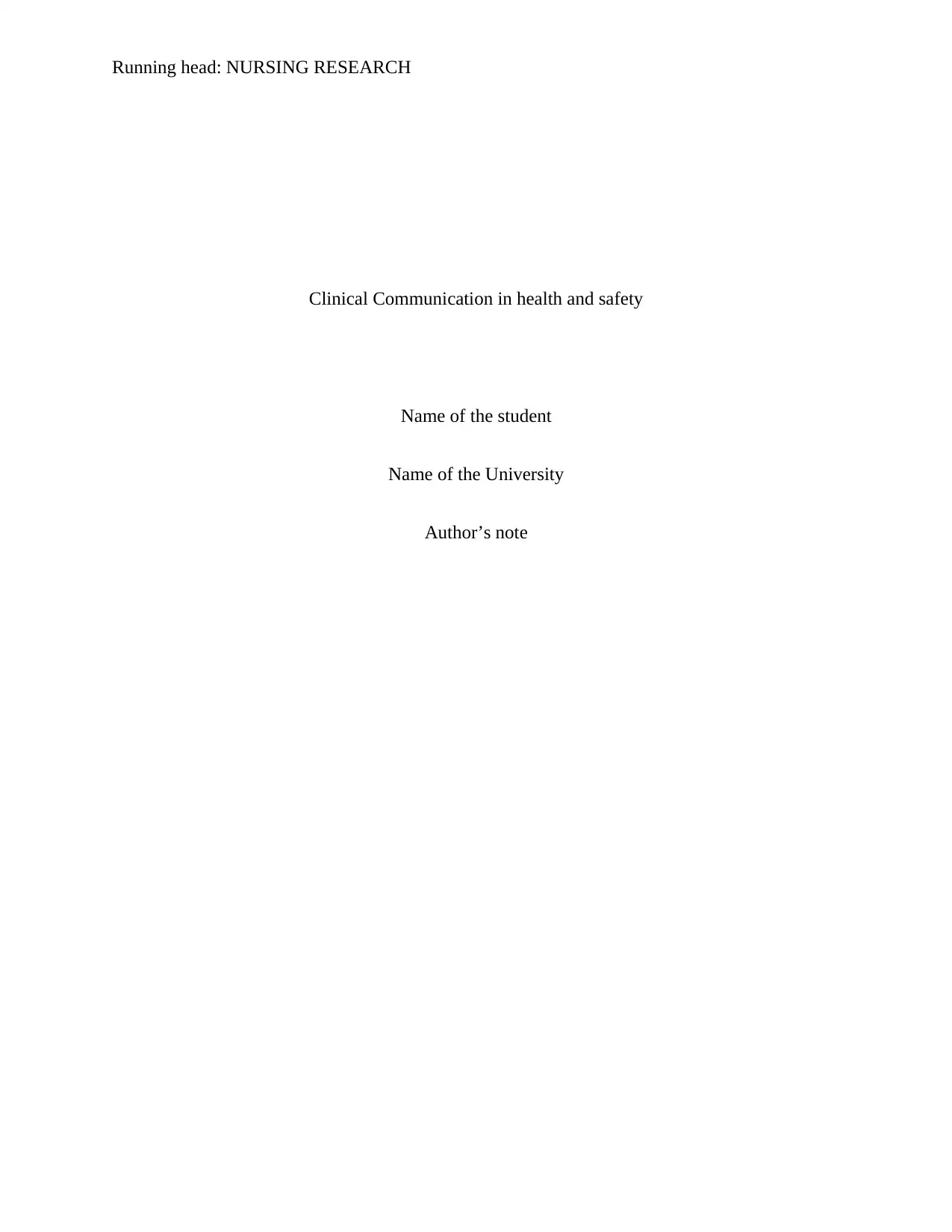
Running head: NURSING RESEARCH
Clinical Communication in health and safety
Name of the student
Name of the University
Author’s note
Clinical Communication in health and safety
Name of the student
Name of the University
Author’s note
Paraphrase This Document
Need a fresh take? Get an instant paraphrase of this document with our AI Paraphraser
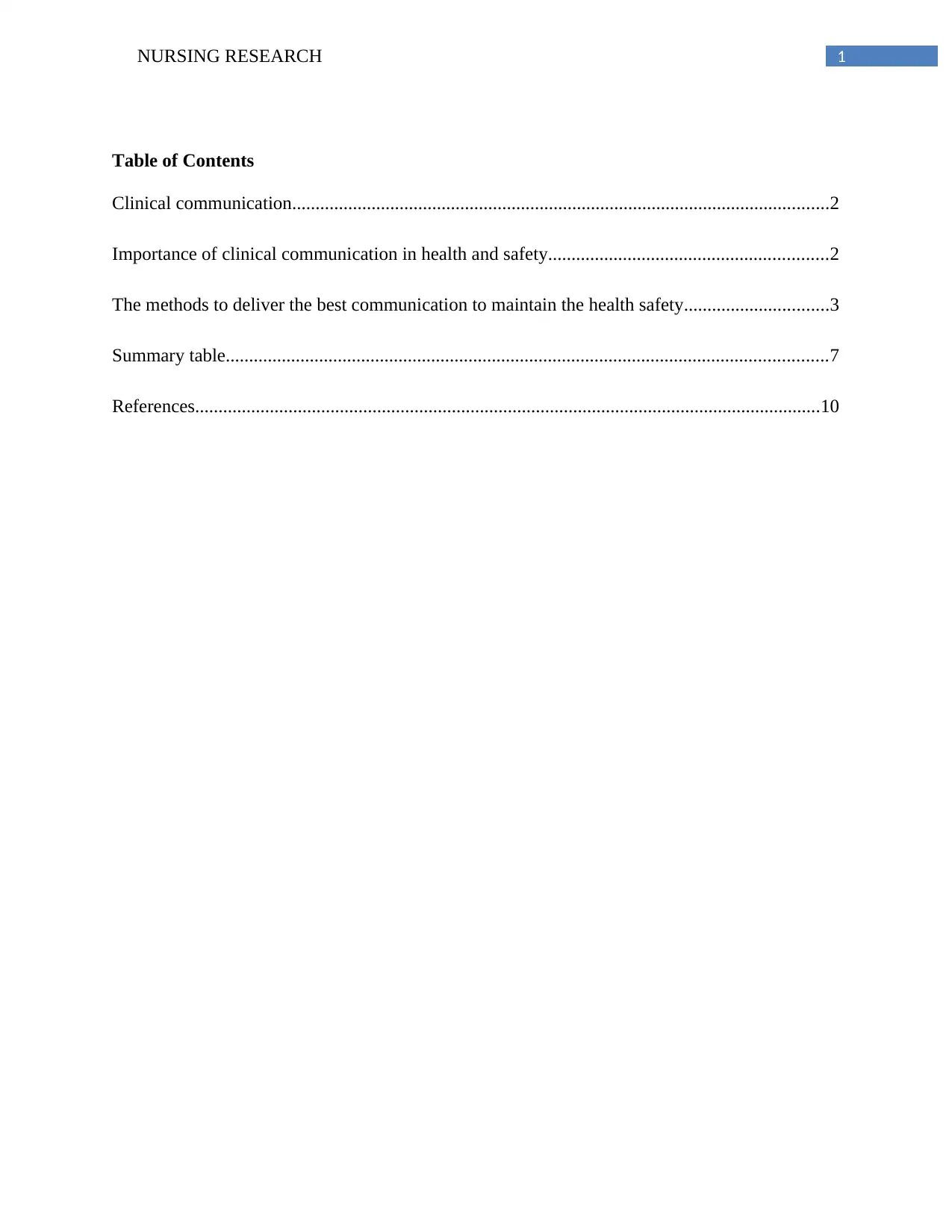
1NURSING RESEARCH
Table of Contents
Clinical communication...................................................................................................................2
Importance of clinical communication in health and safety............................................................2
The methods to deliver the best communication to maintain the health safety...............................3
Summary table.................................................................................................................................7
References......................................................................................................................................10
Table of Contents
Clinical communication...................................................................................................................2
Importance of clinical communication in health and safety............................................................2
The methods to deliver the best communication to maintain the health safety...............................3
Summary table.................................................................................................................................7
References......................................................................................................................................10
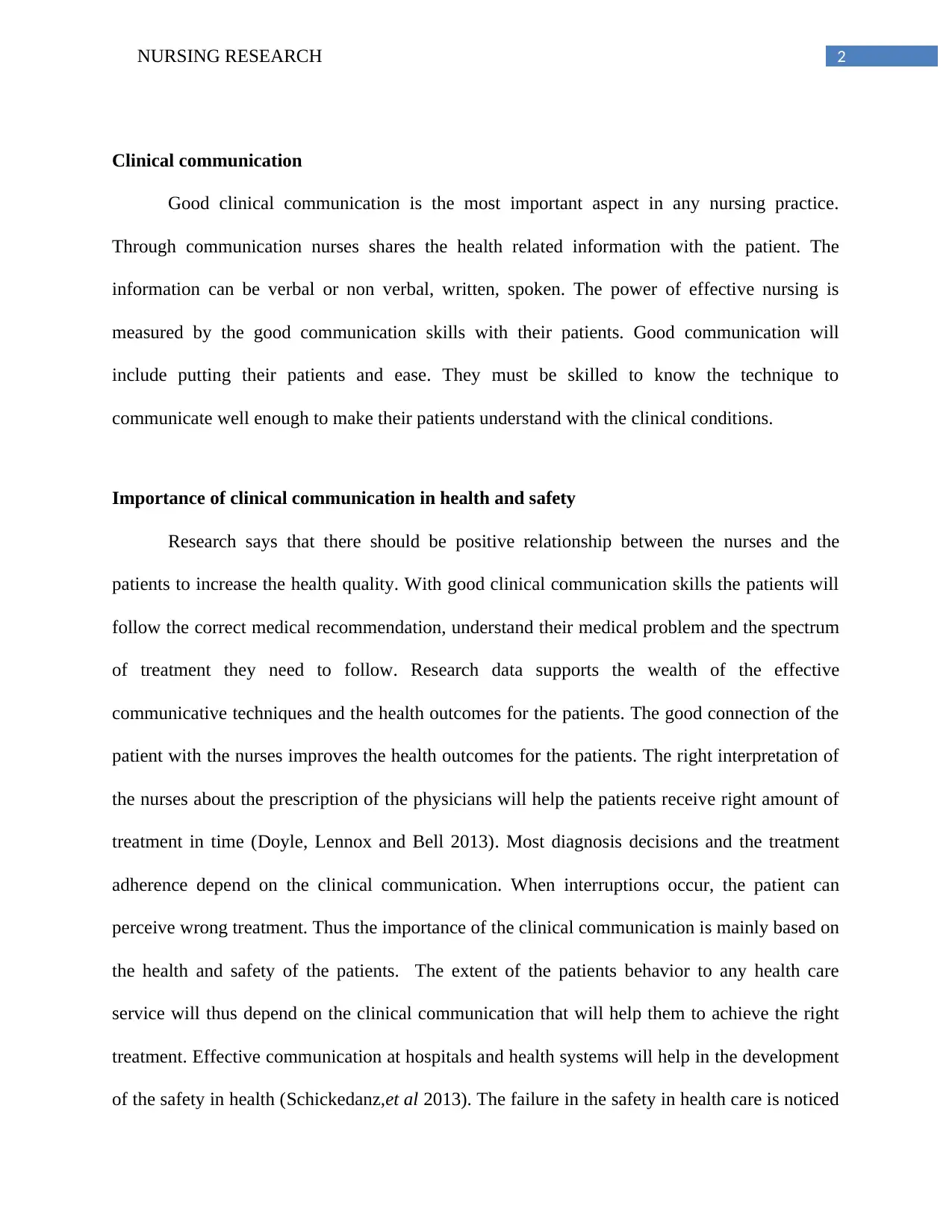
2NURSING RESEARCH
Clinical communication
Good clinical communication is the most important aspect in any nursing practice.
Through communication nurses shares the health related information with the patient. The
information can be verbal or non verbal, written, spoken. The power of effective nursing is
measured by the good communication skills with their patients. Good communication will
include putting their patients and ease. They must be skilled to know the technique to
communicate well enough to make their patients understand with the clinical conditions.
Importance of clinical communication in health and safety
Research says that there should be positive relationship between the nurses and the
patients to increase the health quality. With good clinical communication skills the patients will
follow the correct medical recommendation, understand their medical problem and the spectrum
of treatment they need to follow. Research data supports the wealth of the effective
communicative techniques and the health outcomes for the patients. The good connection of the
patient with the nurses improves the health outcomes for the patients. The right interpretation of
the nurses about the prescription of the physicians will help the patients receive right amount of
treatment in time (Doyle, Lennox and Bell 2013). Most diagnosis decisions and the treatment
adherence depend on the clinical communication. When interruptions occur, the patient can
perceive wrong treatment. Thus the importance of the clinical communication is mainly based on
the health and safety of the patients. The extent of the patients behavior to any health care
service will thus depend on the clinical communication that will help them to achieve the right
treatment. Effective communication at hospitals and health systems will help in the development
of the safety in health (Schickedanz,et al 2013). The failure in the safety in health care is noticed
Clinical communication
Good clinical communication is the most important aspect in any nursing practice.
Through communication nurses shares the health related information with the patient. The
information can be verbal or non verbal, written, spoken. The power of effective nursing is
measured by the good communication skills with their patients. Good communication will
include putting their patients and ease. They must be skilled to know the technique to
communicate well enough to make their patients understand with the clinical conditions.
Importance of clinical communication in health and safety
Research says that there should be positive relationship between the nurses and the
patients to increase the health quality. With good clinical communication skills the patients will
follow the correct medical recommendation, understand their medical problem and the spectrum
of treatment they need to follow. Research data supports the wealth of the effective
communicative techniques and the health outcomes for the patients. The good connection of the
patient with the nurses improves the health outcomes for the patients. The right interpretation of
the nurses about the prescription of the physicians will help the patients receive right amount of
treatment in time (Doyle, Lennox and Bell 2013). Most diagnosis decisions and the treatment
adherence depend on the clinical communication. When interruptions occur, the patient can
perceive wrong treatment. Thus the importance of the clinical communication is mainly based on
the health and safety of the patients. The extent of the patients behavior to any health care
service will thus depend on the clinical communication that will help them to achieve the right
treatment. Effective communication at hospitals and health systems will help in the development
of the safety in health (Schickedanz,et al 2013). The failure in the safety in health care is noticed
⊘ This is a preview!⊘
Do you want full access?
Subscribe today to unlock all pages.

Trusted by 1+ million students worldwide
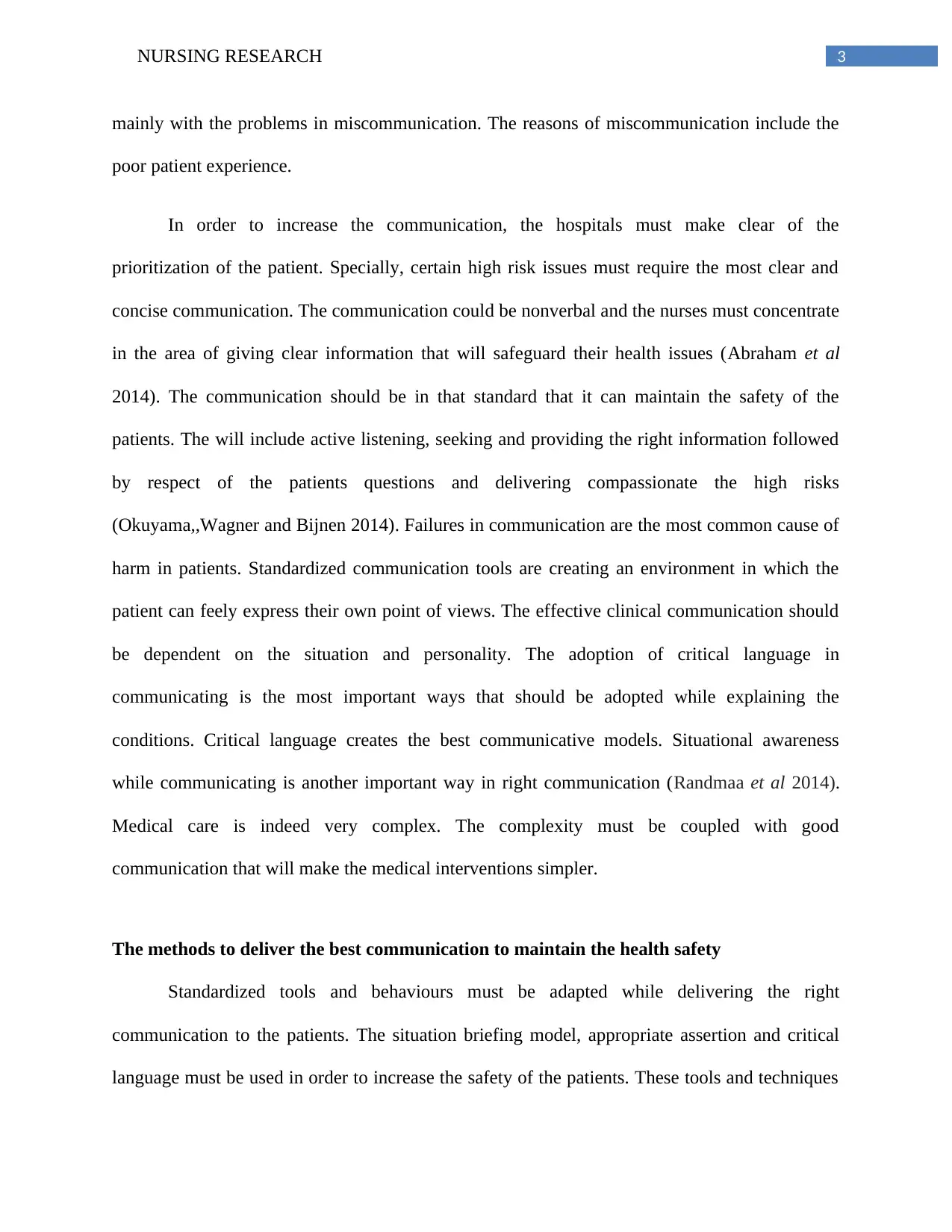
3NURSING RESEARCH
mainly with the problems in miscommunication. The reasons of miscommunication include the
poor patient experience.
In order to increase the communication, the hospitals must make clear of the
prioritization of the patient. Specially, certain high risk issues must require the most clear and
concise communication. The communication could be nonverbal and the nurses must concentrate
in the area of giving clear information that will safeguard their health issues (Abraham et al
2014). The communication should be in that standard that it can maintain the safety of the
patients. The will include active listening, seeking and providing the right information followed
by respect of the patients questions and delivering compassionate the high risks
(Okuyama,,Wagner and Bijnen 2014). Failures in communication are the most common cause of
harm in patients. Standardized communication tools are creating an environment in which the
patient can feely express their own point of views. The effective clinical communication should
be dependent on the situation and personality. The adoption of critical language in
communicating is the most important ways that should be adopted while explaining the
conditions. Critical language creates the best communicative models. Situational awareness
while communicating is another important way in right communication (Randmaa et al 2014).
Medical care is indeed very complex. The complexity must be coupled with good
communication that will make the medical interventions simpler.
The methods to deliver the best communication to maintain the health safety
Standardized tools and behaviours must be adapted while delivering the right
communication to the patients. The situation briefing model, appropriate assertion and critical
language must be used in order to increase the safety of the patients. These tools and techniques
mainly with the problems in miscommunication. The reasons of miscommunication include the
poor patient experience.
In order to increase the communication, the hospitals must make clear of the
prioritization of the patient. Specially, certain high risk issues must require the most clear and
concise communication. The communication could be nonverbal and the nurses must concentrate
in the area of giving clear information that will safeguard their health issues (Abraham et al
2014). The communication should be in that standard that it can maintain the safety of the
patients. The will include active listening, seeking and providing the right information followed
by respect of the patients questions and delivering compassionate the high risks
(Okuyama,,Wagner and Bijnen 2014). Failures in communication are the most common cause of
harm in patients. Standardized communication tools are creating an environment in which the
patient can feely express their own point of views. The effective clinical communication should
be dependent on the situation and personality. The adoption of critical language in
communicating is the most important ways that should be adopted while explaining the
conditions. Critical language creates the best communicative models. Situational awareness
while communicating is another important way in right communication (Randmaa et al 2014).
Medical care is indeed very complex. The complexity must be coupled with good
communication that will make the medical interventions simpler.
The methods to deliver the best communication to maintain the health safety
Standardized tools and behaviours must be adapted while delivering the right
communication to the patients. The situation briefing model, appropriate assertion and critical
language must be used in order to increase the safety of the patients. These tools and techniques
Paraphrase This Document
Need a fresh take? Get an instant paraphrase of this document with our AI Paraphraser
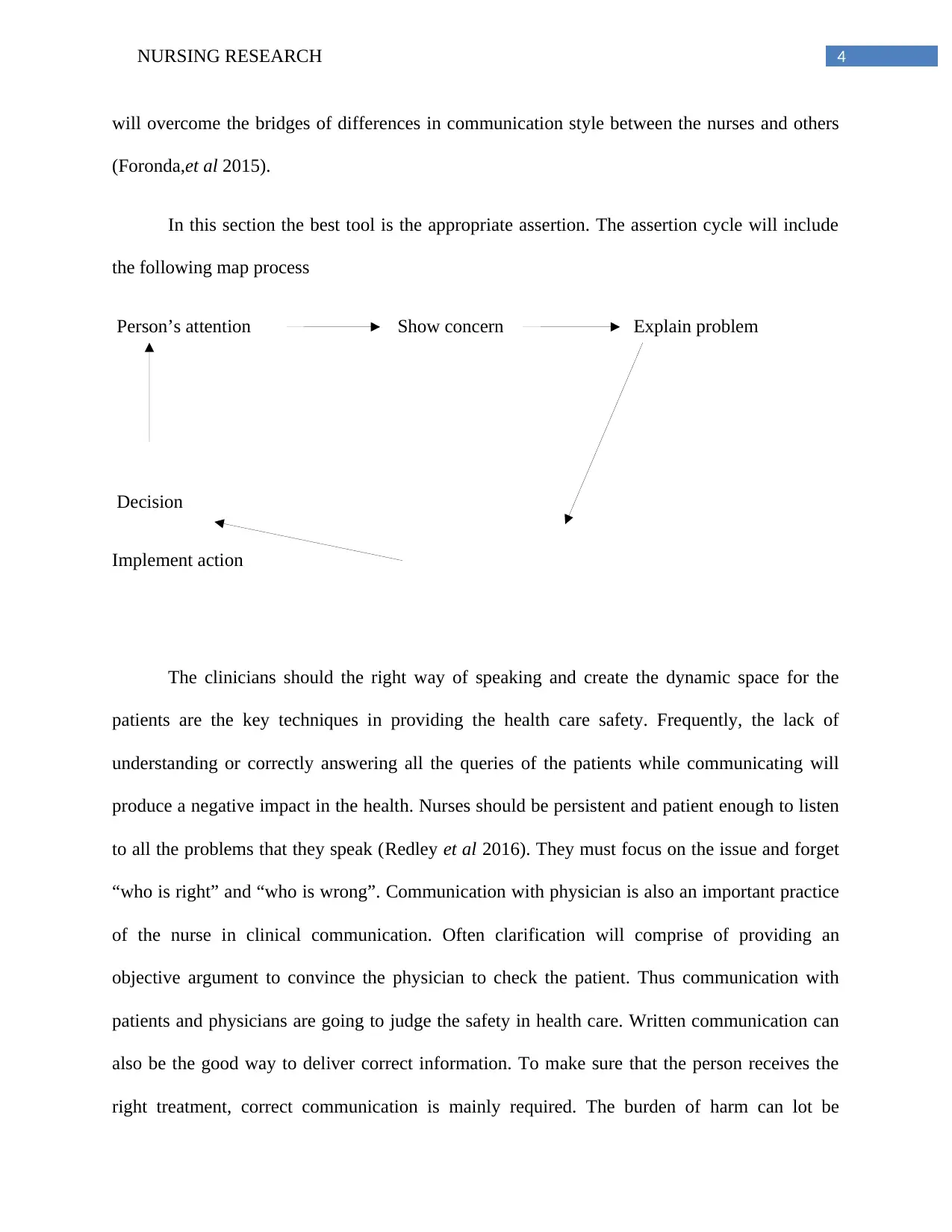
4NURSING RESEARCH
will overcome the bridges of differences in communication style between the nurses and others
(Foronda,et al 2015).
In this section the best tool is the appropriate assertion. The assertion cycle will include
the following map process
Person’s attention Show concern Explain problem
Decision
Implement action
The clinicians should the right way of speaking and create the dynamic space for the
patients are the key techniques in providing the health care safety. Frequently, the lack of
understanding or correctly answering all the queries of the patients while communicating will
produce a negative impact in the health. Nurses should be persistent and patient enough to listen
to all the problems that they speak (Redley et al 2016). They must focus on the issue and forget
“who is right” and “who is wrong”. Communication with physician is also an important practice
of the nurse in clinical communication. Often clarification will comprise of providing an
objective argument to convince the physician to check the patient. Thus communication with
patients and physicians are going to judge the safety in health care. Written communication can
also be the good way to deliver correct information. To make sure that the person receives the
right treatment, correct communication is mainly required. The burden of harm can lot be
will overcome the bridges of differences in communication style between the nurses and others
(Foronda,et al 2015).
In this section the best tool is the appropriate assertion. The assertion cycle will include
the following map process
Person’s attention Show concern Explain problem
Decision
Implement action
The clinicians should the right way of speaking and create the dynamic space for the
patients are the key techniques in providing the health care safety. Frequently, the lack of
understanding or correctly answering all the queries of the patients while communicating will
produce a negative impact in the health. Nurses should be persistent and patient enough to listen
to all the problems that they speak (Redley et al 2016). They must focus on the issue and forget
“who is right” and “who is wrong”. Communication with physician is also an important practice
of the nurse in clinical communication. Often clarification will comprise of providing an
objective argument to convince the physician to check the patient. Thus communication with
patients and physicians are going to judge the safety in health care. Written communication can
also be the good way to deliver correct information. To make sure that the person receives the
right treatment, correct communication is mainly required. The burden of harm can lot be
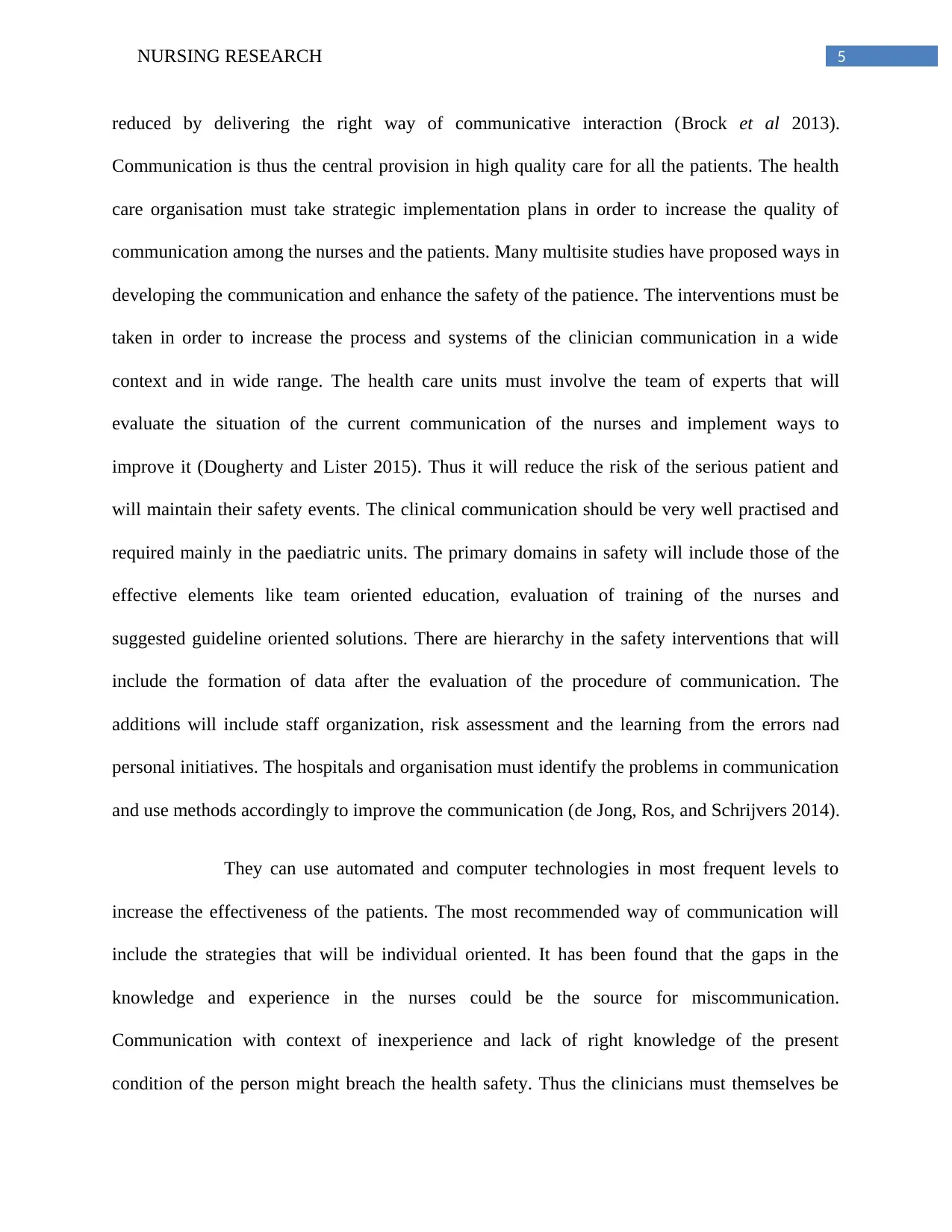
5NURSING RESEARCH
reduced by delivering the right way of communicative interaction (Brock et al 2013).
Communication is thus the central provision in high quality care for all the patients. The health
care organisation must take strategic implementation plans in order to increase the quality of
communication among the nurses and the patients. Many multisite studies have proposed ways in
developing the communication and enhance the safety of the patience. The interventions must be
taken in order to increase the process and systems of the clinician communication in a wide
context and in wide range. The health care units must involve the team of experts that will
evaluate the situation of the current communication of the nurses and implement ways to
improve it (Dougherty and Lister 2015). Thus it will reduce the risk of the serious patient and
will maintain their safety events. The clinical communication should be very well practised and
required mainly in the paediatric units. The primary domains in safety will include those of the
effective elements like team oriented education, evaluation of training of the nurses and
suggested guideline oriented solutions. There are hierarchy in the safety interventions that will
include the formation of data after the evaluation of the procedure of communication. The
additions will include staff organization, risk assessment and the learning from the errors nad
personal initiatives. The hospitals and organisation must identify the problems in communication
and use methods accordingly to improve the communication (de Jong, Ros, and Schrijvers 2014).
They can use automated and computer technologies in most frequent levels to
increase the effectiveness of the patients. The most recommended way of communication will
include the strategies that will be individual oriented. It has been found that the gaps in the
knowledge and experience in the nurses could be the source for miscommunication.
Communication with context of inexperience and lack of right knowledge of the present
condition of the person might breach the health safety. Thus the clinicians must themselves be
reduced by delivering the right way of communicative interaction (Brock et al 2013).
Communication is thus the central provision in high quality care for all the patients. The health
care organisation must take strategic implementation plans in order to increase the quality of
communication among the nurses and the patients. Many multisite studies have proposed ways in
developing the communication and enhance the safety of the patience. The interventions must be
taken in order to increase the process and systems of the clinician communication in a wide
context and in wide range. The health care units must involve the team of experts that will
evaluate the situation of the current communication of the nurses and implement ways to
improve it (Dougherty and Lister 2015). Thus it will reduce the risk of the serious patient and
will maintain their safety events. The clinical communication should be very well practised and
required mainly in the paediatric units. The primary domains in safety will include those of the
effective elements like team oriented education, evaluation of training of the nurses and
suggested guideline oriented solutions. There are hierarchy in the safety interventions that will
include the formation of data after the evaluation of the procedure of communication. The
additions will include staff organization, risk assessment and the learning from the errors nad
personal initiatives. The hospitals and organisation must identify the problems in communication
and use methods accordingly to improve the communication (de Jong, Ros, and Schrijvers 2014).
They can use automated and computer technologies in most frequent levels to
increase the effectiveness of the patients. The most recommended way of communication will
include the strategies that will be individual oriented. It has been found that the gaps in the
knowledge and experience in the nurses could be the source for miscommunication.
Communication with context of inexperience and lack of right knowledge of the present
condition of the person might breach the health safety. Thus the clinicians must themselves be
⊘ This is a preview!⊘
Do you want full access?
Subscribe today to unlock all pages.

Trusted by 1+ million students worldwide
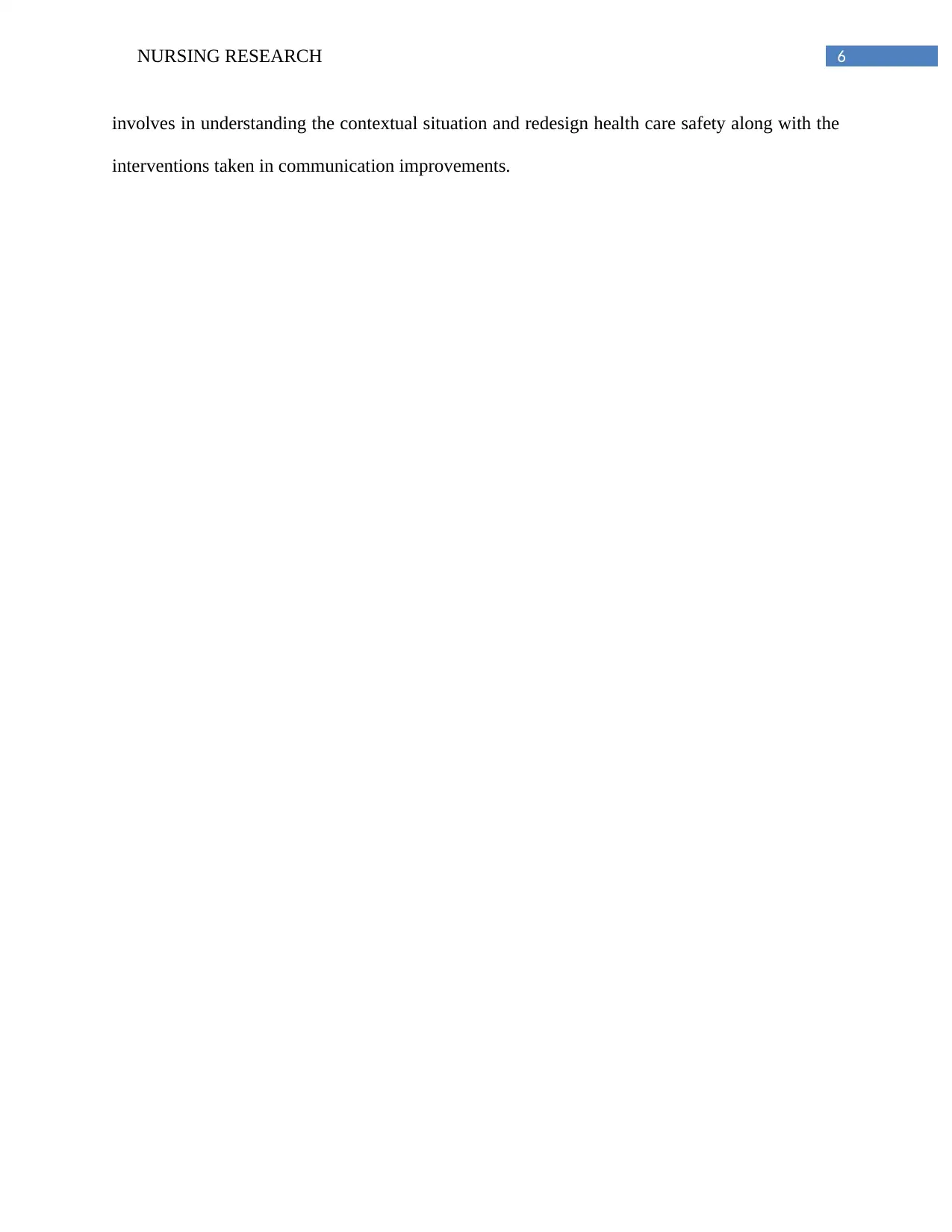
6NURSING RESEARCH
involves in understanding the contextual situation and redesign health care safety along with the
interventions taken in communication improvements.
involves in understanding the contextual situation and redesign health care safety along with the
interventions taken in communication improvements.
Paraphrase This Document
Need a fresh take? Get an instant paraphrase of this document with our AI Paraphraser
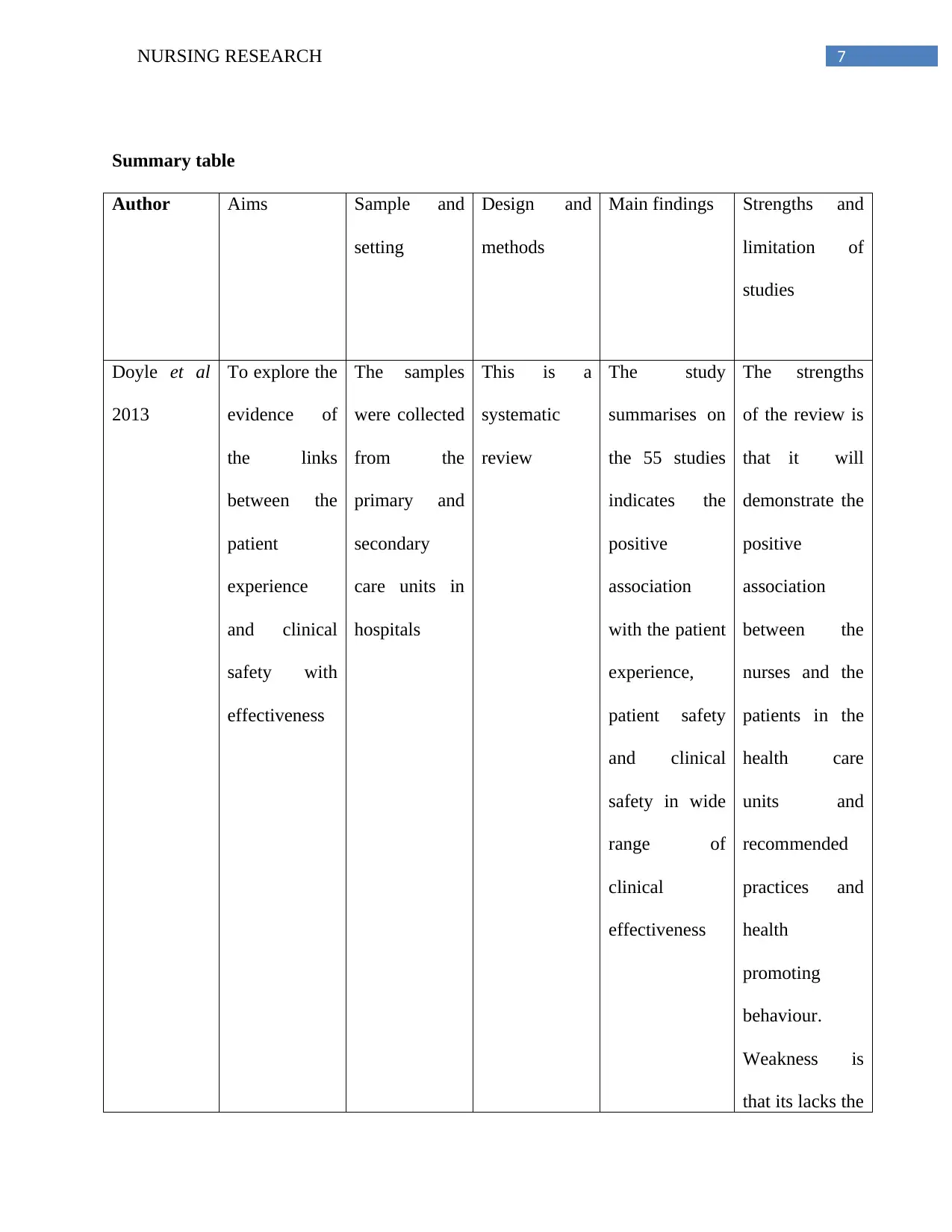
7NURSING RESEARCH
Summary table
Author Aims Sample and
setting
Design and
methods
Main findings Strengths and
limitation of
studies
Doyle et al
2013
To explore the
evidence of
the links
between the
patient
experience
and clinical
safety with
effectiveness
The samples
were collected
from the
primary and
secondary
care units in
hospitals
This is a
systematic
review
The study
summarises on
the 55 studies
indicates the
positive
association
with the patient
experience,
patient safety
and clinical
safety in wide
range of
clinical
effectiveness
The strengths
of the review is
that it will
demonstrate the
positive
association
between the
nurses and the
patients in the
health care
units and
recommended
practices and
health
promoting
behaviour.
Weakness is
that its lacks the
Summary table
Author Aims Sample and
setting
Design and
methods
Main findings Strengths and
limitation of
studies
Doyle et al
2013
To explore the
evidence of
the links
between the
patient
experience
and clinical
safety with
effectiveness
The samples
were collected
from the
primary and
secondary
care units in
hospitals
This is a
systematic
review
The study
summarises on
the 55 studies
indicates the
positive
association
with the patient
experience,
patient safety
and clinical
safety in wide
range of
clinical
effectiveness
The strengths
of the review is
that it will
demonstrate the
positive
association
between the
nurses and the
patients in the
health care
units and
recommended
practices and
health
promoting
behaviour.
Weakness is
that its lacks the
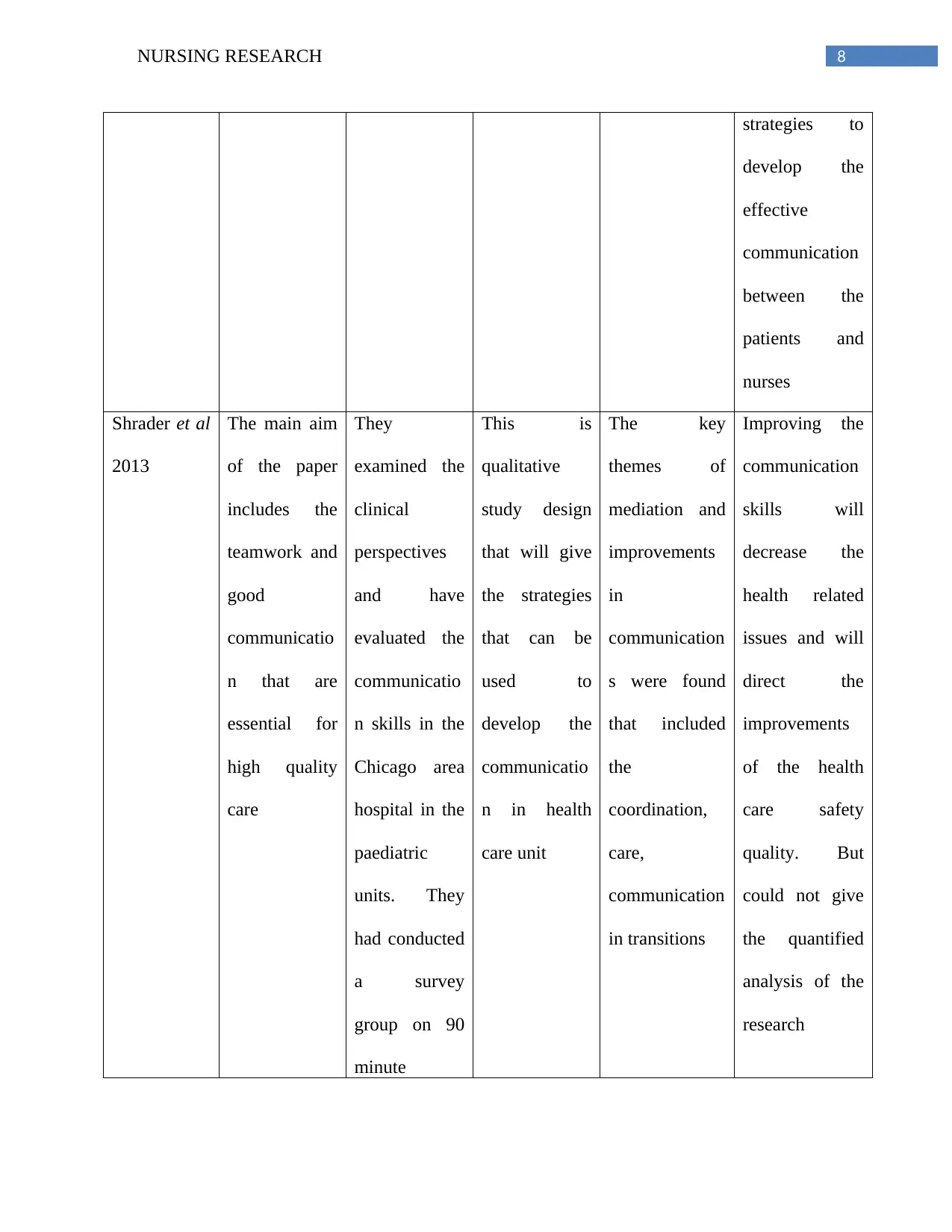
8NURSING RESEARCH
strategies to
develop the
effective
communication
between the
patients and
nurses
Shrader et al
2013
The main aim
of the paper
includes the
teamwork and
good
communicatio
n that are
essential for
high quality
care
They
examined the
clinical
perspectives
and have
evaluated the
communicatio
n skills in the
Chicago area
hospital in the
paediatric
units. They
had conducted
a survey
group on 90
minute
This is
qualitative
study design
that will give
the strategies
that can be
used to
develop the
communicatio
n in health
care unit
The key
themes of
mediation and
improvements
in
communication
s were found
that included
the
coordination,
care,
communication
in transitions
Improving the
communication
skills will
decrease the
health related
issues and will
direct the
improvements
of the health
care safety
quality. But
could not give
the quantified
analysis of the
research
strategies to
develop the
effective
communication
between the
patients and
nurses
Shrader et al
2013
The main aim
of the paper
includes the
teamwork and
good
communicatio
n that are
essential for
high quality
care
They
examined the
clinical
perspectives
and have
evaluated the
communicatio
n skills in the
Chicago area
hospital in the
paediatric
units. They
had conducted
a survey
group on 90
minute
This is
qualitative
study design
that will give
the strategies
that can be
used to
develop the
communicatio
n in health
care unit
The key
themes of
mediation and
improvements
in
communication
s were found
that included
the
coordination,
care,
communication
in transitions
Improving the
communication
skills will
decrease the
health related
issues and will
direct the
improvements
of the health
care safety
quality. But
could not give
the quantified
analysis of the
research
⊘ This is a preview!⊘
Do you want full access?
Subscribe today to unlock all pages.

Trusted by 1+ million students worldwide
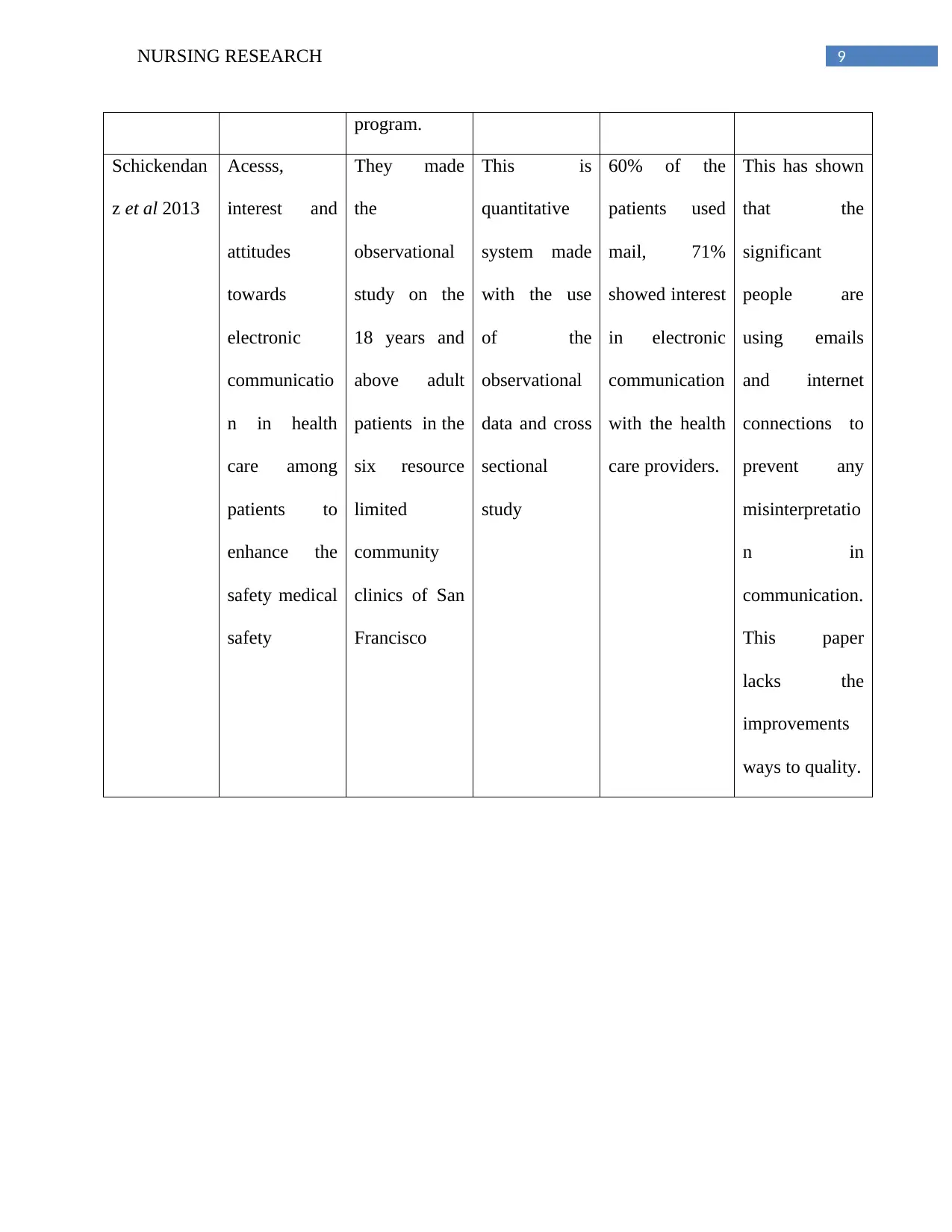
9NURSING RESEARCH
program.
Schickendan
z et al 2013
Acesss,
interest and
attitudes
towards
electronic
communicatio
n in health
care among
patients to
enhance the
safety medical
safety
They made
the
observational
study on the
18 years and
above adult
patients in the
six resource
limited
community
clinics of San
Francisco
This is
quantitative
system made
with the use
of the
observational
data and cross
sectional
study
60% of the
patients used
mail, 71%
showed interest
in electronic
communication
with the health
care providers.
This has shown
that the
significant
people are
using emails
and internet
connections to
prevent any
misinterpretatio
n in
communication.
This paper
lacks the
improvements
ways to quality.
program.
Schickendan
z et al 2013
Acesss,
interest and
attitudes
towards
electronic
communicatio
n in health
care among
patients to
enhance the
safety medical
safety
They made
the
observational
study on the
18 years and
above adult
patients in the
six resource
limited
community
clinics of San
Francisco
This is
quantitative
system made
with the use
of the
observational
data and cross
sectional
study
60% of the
patients used
mail, 71%
showed interest
in electronic
communication
with the health
care providers.
This has shown
that the
significant
people are
using emails
and internet
connections to
prevent any
misinterpretatio
n in
communication.
This paper
lacks the
improvements
ways to quality.
Paraphrase This Document
Need a fresh take? Get an instant paraphrase of this document with our AI Paraphraser
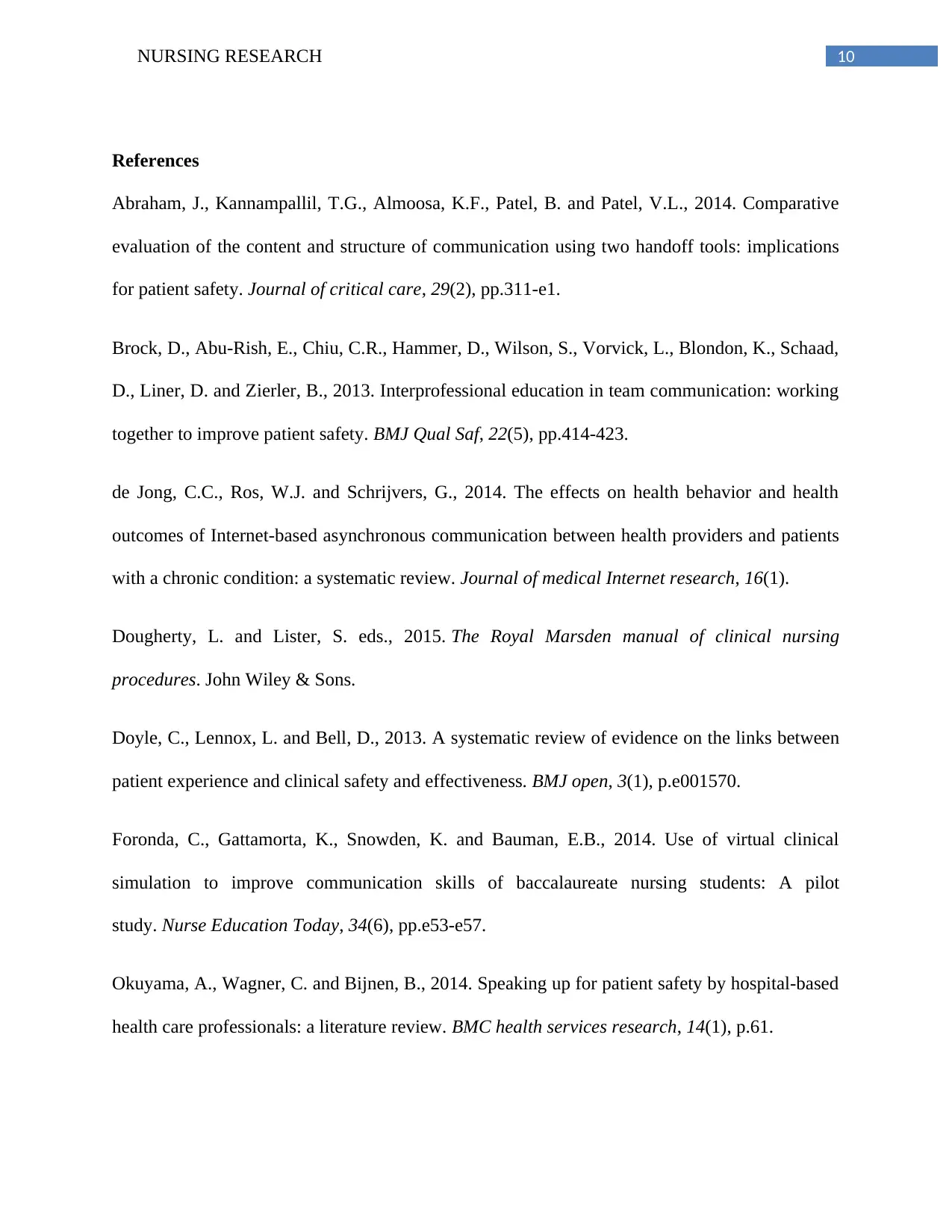
10NURSING RESEARCH
References
Abraham, J., Kannampallil, T.G., Almoosa, K.F., Patel, B. and Patel, V.L., 2014. Comparative
evaluation of the content and structure of communication using two handoff tools: implications
for patient safety. Journal of critical care, 29(2), pp.311-e1.
Brock, D., Abu-Rish, E., Chiu, C.R., Hammer, D., Wilson, S., Vorvick, L., Blondon, K., Schaad,
D., Liner, D. and Zierler, B., 2013. Interprofessional education in team communication: working
together to improve patient safety. BMJ Qual Saf, 22(5), pp.414-423.
de Jong, C.C., Ros, W.J. and Schrijvers, G., 2014. The effects on health behavior and health
outcomes of Internet-based asynchronous communication between health providers and patients
with a chronic condition: a systematic review. Journal of medical Internet research, 16(1).
Dougherty, L. and Lister, S. eds., 2015. The Royal Marsden manual of clinical nursing
procedures. John Wiley & Sons.
Doyle, C., Lennox, L. and Bell, D., 2013. A systematic review of evidence on the links between
patient experience and clinical safety and effectiveness. BMJ open, 3(1), p.e001570.
Foronda, C., Gattamorta, K., Snowden, K. and Bauman, E.B., 2014. Use of virtual clinical
simulation to improve communication skills of baccalaureate nursing students: A pilot
study. Nurse Education Today, 34(6), pp.e53-e57.
Okuyama, A., Wagner, C. and Bijnen, B., 2014. Speaking up for patient safety by hospital-based
health care professionals: a literature review. BMC health services research, 14(1), p.61.
References
Abraham, J., Kannampallil, T.G., Almoosa, K.F., Patel, B. and Patel, V.L., 2014. Comparative
evaluation of the content and structure of communication using two handoff tools: implications
for patient safety. Journal of critical care, 29(2), pp.311-e1.
Brock, D., Abu-Rish, E., Chiu, C.R., Hammer, D., Wilson, S., Vorvick, L., Blondon, K., Schaad,
D., Liner, D. and Zierler, B., 2013. Interprofessional education in team communication: working
together to improve patient safety. BMJ Qual Saf, 22(5), pp.414-423.
de Jong, C.C., Ros, W.J. and Schrijvers, G., 2014. The effects on health behavior and health
outcomes of Internet-based asynchronous communication between health providers and patients
with a chronic condition: a systematic review. Journal of medical Internet research, 16(1).
Dougherty, L. and Lister, S. eds., 2015. The Royal Marsden manual of clinical nursing
procedures. John Wiley & Sons.
Doyle, C., Lennox, L. and Bell, D., 2013. A systematic review of evidence on the links between
patient experience and clinical safety and effectiveness. BMJ open, 3(1), p.e001570.
Foronda, C., Gattamorta, K., Snowden, K. and Bauman, E.B., 2014. Use of virtual clinical
simulation to improve communication skills of baccalaureate nursing students: A pilot
study. Nurse Education Today, 34(6), pp.e53-e57.
Okuyama, A., Wagner, C. and Bijnen, B., 2014. Speaking up for patient safety by hospital-based
health care professionals: a literature review. BMC health services research, 14(1), p.61.
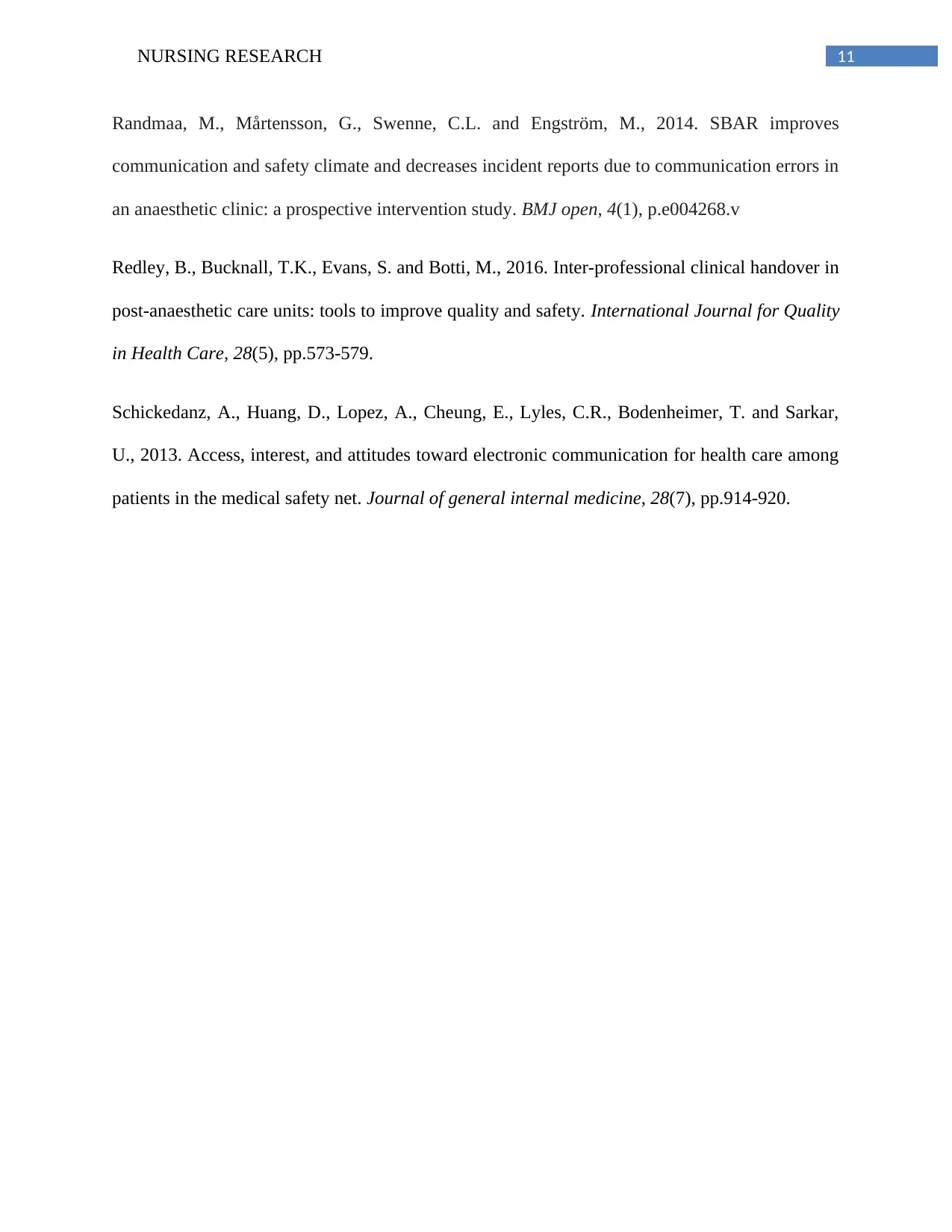
11NURSING RESEARCH
Randmaa, M., Mårtensson, G., Swenne, C.L. and Engström, M., 2014. SBAR improves
communication and safety climate and decreases incident reports due to communication errors in
an anaesthetic clinic: a prospective intervention study. BMJ open, 4(1), p.e004268.v
Redley, B., Bucknall, T.K., Evans, S. and Botti, M., 2016. Inter-professional clinical handover in
post-anaesthetic care units: tools to improve quality and safety. International Journal for Quality
in Health Care, 28(5), pp.573-579.
Schickedanz, A., Huang, D., Lopez, A., Cheung, E., Lyles, C.R., Bodenheimer, T. and Sarkar,
U., 2013. Access, interest, and attitudes toward electronic communication for health care among
patients in the medical safety net. Journal of general internal medicine, 28(7), pp.914-920.
Randmaa, M., Mårtensson, G., Swenne, C.L. and Engström, M., 2014. SBAR improves
communication and safety climate and decreases incident reports due to communication errors in
an anaesthetic clinic: a prospective intervention study. BMJ open, 4(1), p.e004268.v
Redley, B., Bucknall, T.K., Evans, S. and Botti, M., 2016. Inter-professional clinical handover in
post-anaesthetic care units: tools to improve quality and safety. International Journal for Quality
in Health Care, 28(5), pp.573-579.
Schickedanz, A., Huang, D., Lopez, A., Cheung, E., Lyles, C.R., Bodenheimer, T. and Sarkar,
U., 2013. Access, interest, and attitudes toward electronic communication for health care among
patients in the medical safety net. Journal of general internal medicine, 28(7), pp.914-920.
⊘ This is a preview!⊘
Do you want full access?
Subscribe today to unlock all pages.

Trusted by 1+ million students worldwide
1 out of 12
Related Documents
Your All-in-One AI-Powered Toolkit for Academic Success.
+13062052269
info@desklib.com
Available 24*7 on WhatsApp / Email
![[object Object]](/_next/static/media/star-bottom.7253800d.svg)
Unlock your academic potential
Copyright © 2020–2025 A2Z Services. All Rights Reserved. Developed and managed by ZUCOL.





